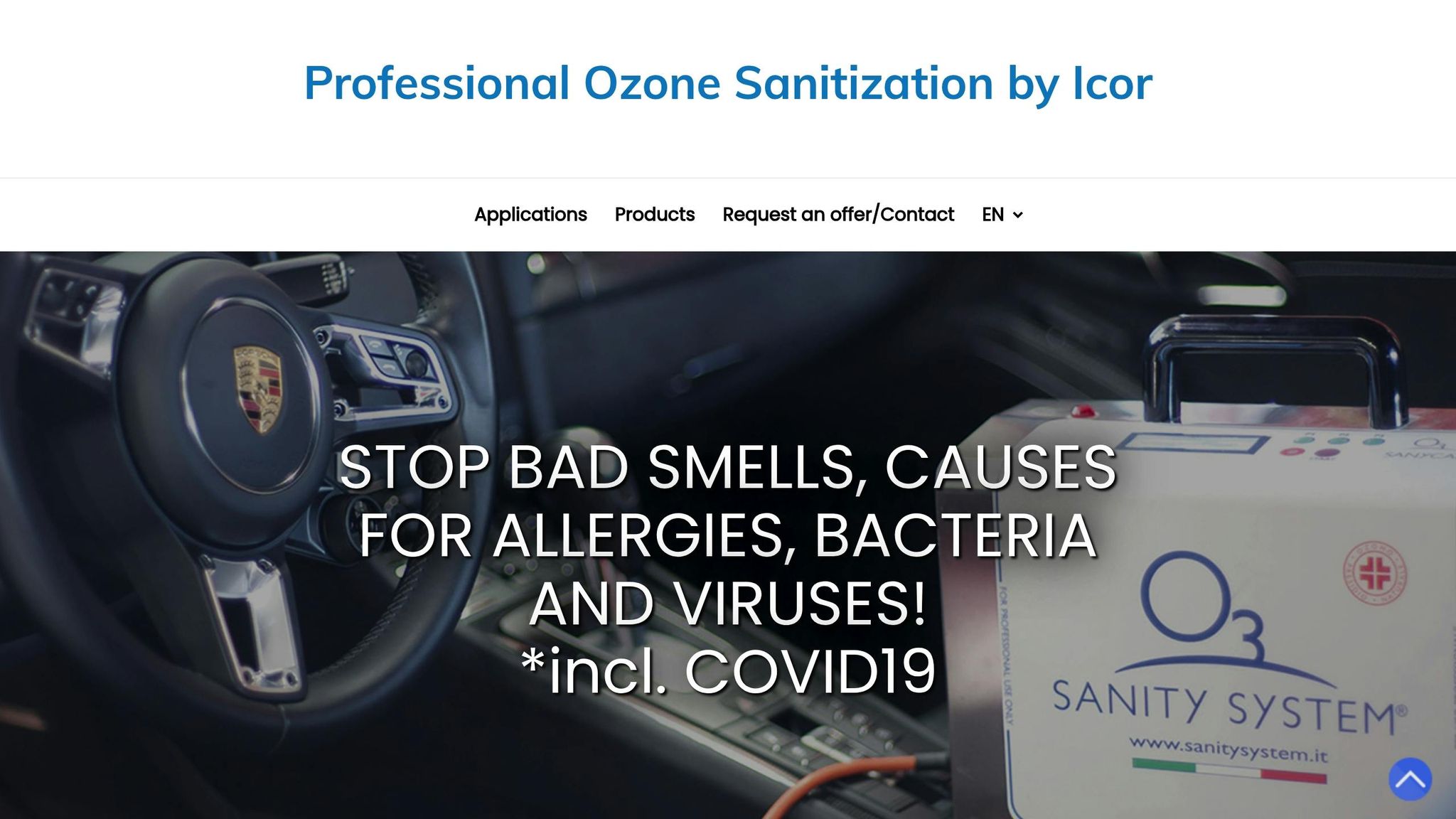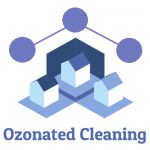Fleet vehicles are a breeding ground for bacteria, fungi, and viruses, posing serious health risks to drivers and passengers. Ozone treatment offers a fast, effective, and safe solution for disinfecting vehicles, eliminating up to 99% of pathogens without leaving harmful residues.
Key Takeaways:
- Why It Matters: Fleet vehicles can harbor over 26,000 CFU/mg of bacteria and 1,200 CFU/mg of fungi, increasing the risk of illness.
- Why Ozone Works: Ozone gas reaches hard-to-clean areas like air vents and upholstery, neutralizing pathogens and odors with no chemical residue.
- Benefits:
- Reduces downtime (treatment takes 2–3 hours).
- No need for chemical cleaners or water.
- Safe when handled correctly, leaving no toxic byproducts.
- Challenges with Traditional Cleaning: Chemical cleaners can leave harmful residues, emit VOCs, and are time-consuming.
Ozone disinfection is a practical, eco-friendly way to keep fleet vehicles safe and operational while addressing hygiene challenges.
Sany car – The ozone disinfection system by ICOR

Current Fleet Cleaning Limitations
Overcoming the challenges of current cleaning methods is crucial to making a case for ozone treatment as a better option. Traditional cleaning techniques often fall short in terms of efficiency and safety, pushing fleet managers to explore alternatives that can deliver more reliable sanitization.
Problems with Chemical Cleaners
Chemical cleaning products come with their fair share of risks. Many industrial cleaners contain volatile organic compounds (VOCs), which are linked to respiratory problems, skin irritation, and headaches. Even products labeled as "green" or "natural" aren’t always free from harmful ingredients, according to research by the American Lung Association. Additionally, residues left behind by some cleaners can reduce the effectiveness of subsequent disinfectants.
These chemicals don’t just pose health risks – they also harm the environment. VOC emissions contribute to poor air quality, while chemical runoff can contaminate water supplies and soil.
"It’s ironic that the chemicals we’re deploying in vain for one health crisis are actually fueling another." – Erica Hartmann, Associate Professor of Civil and Environmental Engineering at Northwestern University
The drawbacks of chemical cleaners also extend to how they affect fleet operations.
Impact on Fleet Operations
The issues with traditional cleaning methods go beyond health and environmental concerns – they also disrupt operational efficiency. Regular cleaning is vital to protect vehicle components and address seasonal challenges like salt buildup during winter. However, current practices often deliver inconsistent results.
Here are some of the main operational challenges:
- Extended Downtime: Labor-intensive cleaning processes keep vehicles out of service for longer periods.
- Inconsistent Results: Manual cleaning can vary in quality, potentially missing critical areas.
- High Resource Use: Excessive reliance on water and chemicals drives up costs.
When cleaning is inconsistent, it not only increases the risk of pathogens remaining on surfaces but can also hide early signs of mechanical problems, such as worn lines or electrical issues. For instance, studies have shown that viruses like SARS-CoV-2 can survive on materials like plastic and stainless steel for up to seven days. This highlights the importance of thorough and effective sanitization methods.
Ozone Treatment Method
Ozone treatment plays a critical role in disinfecting vehicle fleets, thanks to ozone’s strong sanitizing capabilities. However, it’s essential to follow strict safety guidelines to ensure both effectiveness and safety during the process.
Treatment Steps and Safety
The ozone treatment process requires careful preparation and adherence to safety protocols. First, all surfaces inside the vehicle must be completely dry since moisture can interfere with ozone’s effectiveness. Personal items should be removed, and seatbelts covered to prevent exposure damage.
Here’s how the process works:
- Vehicle Preparation: Start by thoroughly cleaning and vacuuming the vehicle. Open all compartments to ensure every area is treated, and then seal the vehicle to contain the ozone.
- Equipment Setup: Place the ozone generator inside the vehicle or use an external system that channels ozone into the cabin through a hose. The setup will depend on the size of the vehicle and the level of contamination.
- Treatment Process: Run the ozone generator for 30–90 minutes. During the final quarter of the treatment time, turn on the air conditioning to deodorize the vents and HVAC system.
Safety is a top priority throughout the process. The following measures should be in place:
| Safety Protocol | Implementation Details |
|---|---|
| Area Access | Keep all personnel out of the treatment area. |
| Ventilation | Ensure proper airflow after the treatment is complete. |
| Monitoring | Use timers to control the treatment duration precisely. |
| PPE Requirements | Provide technicians with appropriate protective gear. |
| Emergency Plans | Have clear procedures for accidental ozone exposure. |
By following these steps and safety measures, fleets can be disinfected effectively while keeping technicians and others safe.
Scheduling and Timing
Proper scheduling is key to balancing thorough disinfection with minimal fleet downtime. A typical ozone treatment process includes:
- Treatment Duration: The active ozone treatment itself takes 30–90 minutes.
- Ventilation Period: Allow 30–60 minutes for ventilation after the treatment.
- Total Process Time: Including preparation and ventilation, the entire process takes about 2–3 hours.
For consistent results, ozone treatments can be scheduled as part of monthly or quarterly maintenance routines. After treatment, ventilate the vehicle for at least two hours per hour of treatment to ensure safety and maintain the sanitizing benefits. This approach ensures a balance between effective disinfection and operational efficiency.
sbb-itb-5fea4da
Treatment Results and Benefits
Pathogen Reduction Data
Field studies have shown that ozone treatment is highly effective at reducing pathogens in fleet vehicles. For instance, a thorough trial conducted on public transit vehicles demonstrated a 3.65-log reduction in murine hepatitis virus and a 4.73-log reduction in Staphylococcus aureus. Other research highlights that ozone can inactivate up to 99% of bacteria and viruses when used under optimal conditions.
The efficiency of ozone treatment depends on both its concentration and the duration of exposure. Here’s a breakdown of the results based on different conditions:
| Ozone Concentration | Exposure Time | Results |
|---|---|---|
| 0.05–0.1 ppm | 30 minutes | Safe for humans and effective against the COVID‑19 virus |
| 2 ppm | 20 minutes | Significant bacterial inactivation across surfaces |
| 10 ppm | 2 minutes | 1‑log reduction in bacterial counts with no regrowth |
The data clearly demonstrates that ozone treatment is not only effective but also adaptable to varying needs, offering a reliable solution for pathogen control.
Cost and Time Savings
Beyond its disinfection capabilities, ozone treatment offers noticeable savings in both time and money, surpassing traditional manual cleaning methods. Here’s how:
| Benefit Category | Impact |
|---|---|
| Treatment Duration | Completion time ranges from 21 to 90 minutes |
| Labor Requirements | Minimal staffing thanks to automated systems |
| Chemical Costs | Eliminates the need for cleaning agents and disinfectants |
| Downtime Reduction | Faster turnaround compared to manual cleaning |
| Residual Effects | Leaves no toxic residue, avoiding extra cleanup |
An example of this success is BSA Rushcutters Bay, which implemented ozone treatment for fleet maintenance and achieved effective disinfection without the drawbacks of traditional methods.
"Unlike traditional ‘deep cleaning’ processes, that use spraying and wiping, fogging or misting, there are no sprays, no wipes and no toxic chemical fumes or residue to clean up. Our process is faster, more efficient and less expensive." – Ozone Disinfection
These benefits make ozone treatment a practical and efficient choice for organizations looking to improve sanitation while reducing operational costs and downtime.
Conclusion
Key Benefits
Ozone treatment stands out as a highly effective method for disinfecting fleet vehicles. With an oxidation potential of 2.07 volts – far surpassing chlorine’s 1.36 volts – ozone ensures exceptional pathogen elimination while overcoming common operational hurdles.
Here’s a quick look at the advantages:
| Benefit Category | Impact |
|---|---|
| Disinfection Efficacy | Eliminates up to 99% of bacteria, viruses, and fungi |
| Coverage | Reaches deep into upholstery, vents, and hard-to-access areas |
| Environmental Impact | Breaks down into oxygen, leaving no harmful residues |
| Operational Efficiency | Low maintenance requirements and cost-effective operation |
| Temperature Performance | Retains effectiveness even in warmer conditions |
Ozone’s efficiency is further demonstrated by its low CT value – just 0.5 mg_min/L compared to chlorine dioxide’s 12.5 mg_min/L. This means ozone achieves thorough sanitization with far less chemical exposure, making it a practical and reliable choice.
Professional Services
For fleet operators seeking expert solutions, Ozonated Cleaning LLC offers tailored ozone treatment services. Their FDA-approved methods ensure a safe and thorough sanitization process, including:
- Customized treatment plans designed to fit your fleet size and schedule.
- Professional-grade application using calibrated equipment for precision.
- Comprehensive interior cleaning that covers every corner of the vehicle.
- Post-treatment verification to ensure optimal results.
What sets ozone apart is its balance of performance and safety. Research from Fujita Health University shows that even low ozone concentrations (0.05 to 0.1 ppm) effectively neutralize pathogens without posing risks to human health.
With its proven ability to disinfect, ease of use, and eco-friendly nature, ozone treatment is a smart choice for keeping fleet vehicles clean and safe.
FAQs
How is ozone treatment safer and more eco-friendly than traditional chemical cleaning methods?
Ozone treatment offers a safer and greener option compared to traditional chemical cleaning methods. One of its key advantages is that ozone naturally reverts to oxygen after use, leaving behind no harmful residues or by-products. This means it doesn’t pollute water systems, endanger aquatic life, or add to chemical waste – a win for both the environment and public health.
On top of that, ozone’s strong oxidative properties can tackle a wide range of pathogens effectively. Unlike conventional disinfectants, it doesn’t contribute to the growing issue of antimicrobial resistance. Its ability to disinfect thoroughly without leaving behind chemical traces makes it a smart, health-conscious solution for many applications.
What steps and safety measures are involved in disinfecting fleet vehicles with ozone treatment?
Ozone Treatment for Fleet Vehicles
Ozone treatment for fleet vehicles involves a step-by-step process to ensure effective disinfection and safety. The first step is cleaning the vehicle to remove dirt and debris, as ozone works best on clean surfaces. After cleaning, all windows and doors are closed to keep the ozone contained. An ozone generator is then placed inside the vehicle or connected via a hose to evenly distribute ozone throughout the cabin. The treatment duration typically ranges from 30 minutes to several hours, depending on the level of contamination or odors present.
Safety measures are crucial during ozone treatment. No one, including pets, should remain in the vehicle while the treatment is underway, as inhaling ozone can be harmful. Once the process is complete, the vehicle must be ventilated by opening windows and doors to let any remaining ozone dissipate. Operators handling the treatment should wear protective gear, such as masks and gloves, to minimize exposure to high ozone levels. After these steps, the vehicle is ready for use again.
How often should fleet vehicles undergo ozone treatments for effective disinfection with minimal downtime?
Fleet vehicles should generally get ozone treatments every 1 to 3 months to maintain cleanliness and reduce downtime. The exact frequency depends on how often the vehicles are used and their exposure to odors or pathogens. For vehicles that see heavy use or regularly transport passengers, monthly treatments can be especially helpful, particularly when combined with routine cleaning efforts.
Aligning ozone treatments with regular maintenance schedules is a smart way to keep disinfection consistent without interrupting operations. This approach helps ensure your fleet stays clean, safe, and ready for action.


Recent Comments